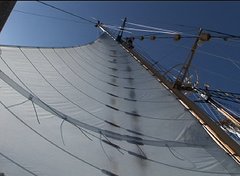The Stanford@SEA 2013 Cruise has travelled over 600 nm due
south of Hawaii on our way to the Line Islands with a first stop at Palmyra Atoll. Sailing
has been superb as Force 5 winds have pushed us hard to the south. We have a
remarkable group of student/sailors on board and the energy, enthusiasm and
creativity is overflowing on the decks of the Robert Seamans. The Scientific
and professional sailing staff have been amazed at this year's Stanford class, and together with the Professors and
visiting scientists they are carrying out an ambitious oceanographic sampling
plan that includes two stations a day with CTDs, two net tows and a variety of
other sampling gear in the water.
 |
| Evan and Nicole learning to take the first fixes at sea |
We’re measuring pC02 with a set up Dr. Rob Dunbar has provided, and examining the distribution of animal sentinels such as pteropods, examining their biodiversity and distribution. This species which is a critical member of the pelagic food chain is important as an indicator species for environmental change. We did a fantastic eddy project early on as we hit a anticylonic eddy south of Hawaii and captured wonderful data that Walter Torres will use in his project, Kakani Young’s team a Woods Hole Oceanographic visiting investigator has been able to image particles around a variety of critters- despite all odds (imagine a moving ship hurling up and down) and sophisticated imagery capturing how small invertebrates and vertebrates move abounds despite the circumstances.
Other projects include
sampling the blood, stomach contents and biomechanics of fish brought on board
(spearfish, mahi and a wahoo so far), and now we’re moving into the focus on
the OML. Nightly squid jigging has produced a few successes but we are
currently in the low productivity area of our track. Currently a lot of emphasis
is on the rapidly shoaling oxycline and the interest in the oxygen minimum zone
of the central Pacific. A series of 4 daily stations over the next few days
will help us discern the relationship between the physical oceanography and the
biology.
 |
| Mystery fish caught in an evening tow - may be an angler of some sort |
The big news is this cool new fish we found- we don’t know what it is- it seems to be somewhat like an Angler fish, but then I think maybe a baby Opah! But none of us on board know what it is! Just another day aboard the Bobby C!
-Chief Scientist Barbara Block



No comments:
Post a Comment